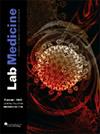A 1-Day-Old Neonate Presents With an Unexpected Antibody
IF 1
4区 医学
Q4 MEDICAL LABORATORY TECHNOLOGY
引用次数: 0
Abstract
Patient: 1-day-old Caucasian male neonate. History of Present Illness: The neonate was born to a 26-year-old gravida 1 female at 37 weeks gestational age via Caesarean section, secondary to failure to progress in labor. The infant was delivered without complications. Routine blood work on the infant revealed an unexpected red cell antibody. A direct antiglobulin test (DAT) and antibody screen were both noted to be positive. Past Medical History: The mother received routine prenatal care throughout her pregnancy. She has a past medical history of chronic hypertension, an anti-E antibody, a pan-reactive autoantibody to red cell antigens, and mild intermittent asthma. The anti-E was discovered upon prenatal screening in the mother, but was not identified in subsequent auto-absorbed specimens. No previous transfusions were documented. Social History: Non-contributory. Family History: Non-contributory. Physical Exam: The neonate’s APGAR scores were 8 at 1 minute and 9 at 5 minutes. An exam showed the neonate to be in no acute distress and with essentially normal physical findings. Principal Laboratory Findings: See Table 1, Table 2, Table 3, and Table 4. 1. What are the mother’s most striking laboratory findings? 2. The mother and neonate share the same antibody identification panel in Tables 3 and 4. Why? 3. What autoimmune conditions of pregnant women have been observed to produce transplacental antibodies resulting in neonatal disease? 4. What additional workup is necessary …一个1天大的新生儿出现了意想不到的抗体
患者:1天大的白人男性新生儿。现病史:新生儿为26岁孕妇1号,孕龄37周,继发于难产。婴儿出生时没有并发症。婴儿的常规血液检查发现了一种意想不到的红细胞抗体。直接抗球蛋白试验(DAT)和抗体筛选均为阳性。既往病史:母亲在妊娠期间接受常规产前护理。既往有慢性高血压病史,抗e抗体,红细胞抗原泛反应性自身抗体,轻度间歇性哮喘。母体产前筛查时发现了抗e,但在随后的自体吸收标本中未发现。既往无输血记录。社会历史:无贡献。家族史:无贡献。体格检查:新生儿APGAR评分1分钟为8分,5分钟为9分。检查显示,新生儿没有急性窘迫,身体检查结果基本正常。主要实验室结果:见表1、表2、表3和表4.1。这位母亲最引人注目的实验室发现是什么?在表3和表4中,母亲和新生儿共享相同的抗体鉴定面板。为什么? 3。观察到孕妇的哪些自身免疫状况会产生经胎盘抗体导致新生儿疾病?还需要做什么额外的检查?
本文章由计算机程序翻译,如有差异,请以英文原文为准。
求助全文
约1分钟内获得全文
求助全文
来源期刊

Labmedicine
医学-医学实验技术
CiteScore
2.50
自引率
0.00%
发文量
155
审稿时长
>12 weeks
期刊介绍:
Lab Medicine is a peer-reviewed biomedical journal published quarterly by the ASCP and Oxford University Press. The journal invites submission of manuscripts on topics related to clinical chemistry and microbiology, hematology, immunology, transfusion medicine, molecular diagnostics, cytology, histology, and laboratory administration and management. Original research, reviews, and case reports are considered for publication. Lab Medicine is indexed (under the title Laboratory Medicine) by the National Library of Medicine and is included in the PubMed database.
 求助内容:
求助内容: 应助结果提醒方式:
应助结果提醒方式:


